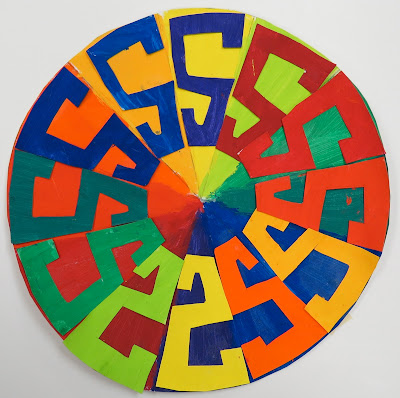Sinking Springs 6th grade artists created non-objective or symbolic, metal repoussé designs that focused on line, pattern, and TEXTURE.
Repoussé is a type of low relief sculpture in which form projects from a background. Repoussé is a French word which means to push.
Using the Repoussé method, students created their metal reliefs by pushing the metal foil with dull pencils and wooden tools. Completed foil designs were then "antiqued" using black india ink and steel wool, and/or coloring with sharpie markers.
Next, students matted their artwork and were presented with the challenge
of continuing their 3-D design onto the 2-D surface of their construction paper using color pencils and/or metallic markers.
|
Thursday, October 24, 2013
TEXTURE - Metal Repoussé - 6th Grade
Tuesday, January 15, 2013
COMPLEMENTARY COLOR WHEELS - 5th
Thank you to h_mazzuto at Art, Paper, Scissors, Glue for the basic idea for this lesson.
Our 5th grade artists reviewed the primary, secondary, and complementary colors and why they are positioned where they are on the color wheel. We then talked about the intermediate or tertiary colors and how we can mix specific primary and secondary colors to create them. For example yellow
and green mix to make yellow-green.
1. Students traced a circle template on their 12"x12"white drawing paper.
They also marked their circle with the 12 markers on the template. These
marks were on each template to use as a guide on where to draw the lines
to create the 12 triangles for their color wheel.
2. Students drew the lines connecting the opposite marks on their circles,
making sure they intersected the center point on their circle.
3. The students then lightly marked the initials for each color in the
appropriate triangles as a reminder of what color to paint them.
appropriate triangles as a reminder of what color to paint them.
4. Two tempera paint containers with two easel brushes at each color
were placed on each of the six tables in the room. The students took
turns painting their triangles the corresponding colors.
5. The next art class the students were given a white paper triangle
the size of the triangles of the color wheel. The drew and cut out
a shape to use as a repetitive pattern on their color wheel.
6. The students traced their shape 12 times on another piece of white
drawing paper.
7. They then painted each of the twelve shapes. When they were dry
they cut them out glued them onto the colors complementary color.
8. This project makes a striking display in the hallway!
Subscribe to:
Comments (Atom)










